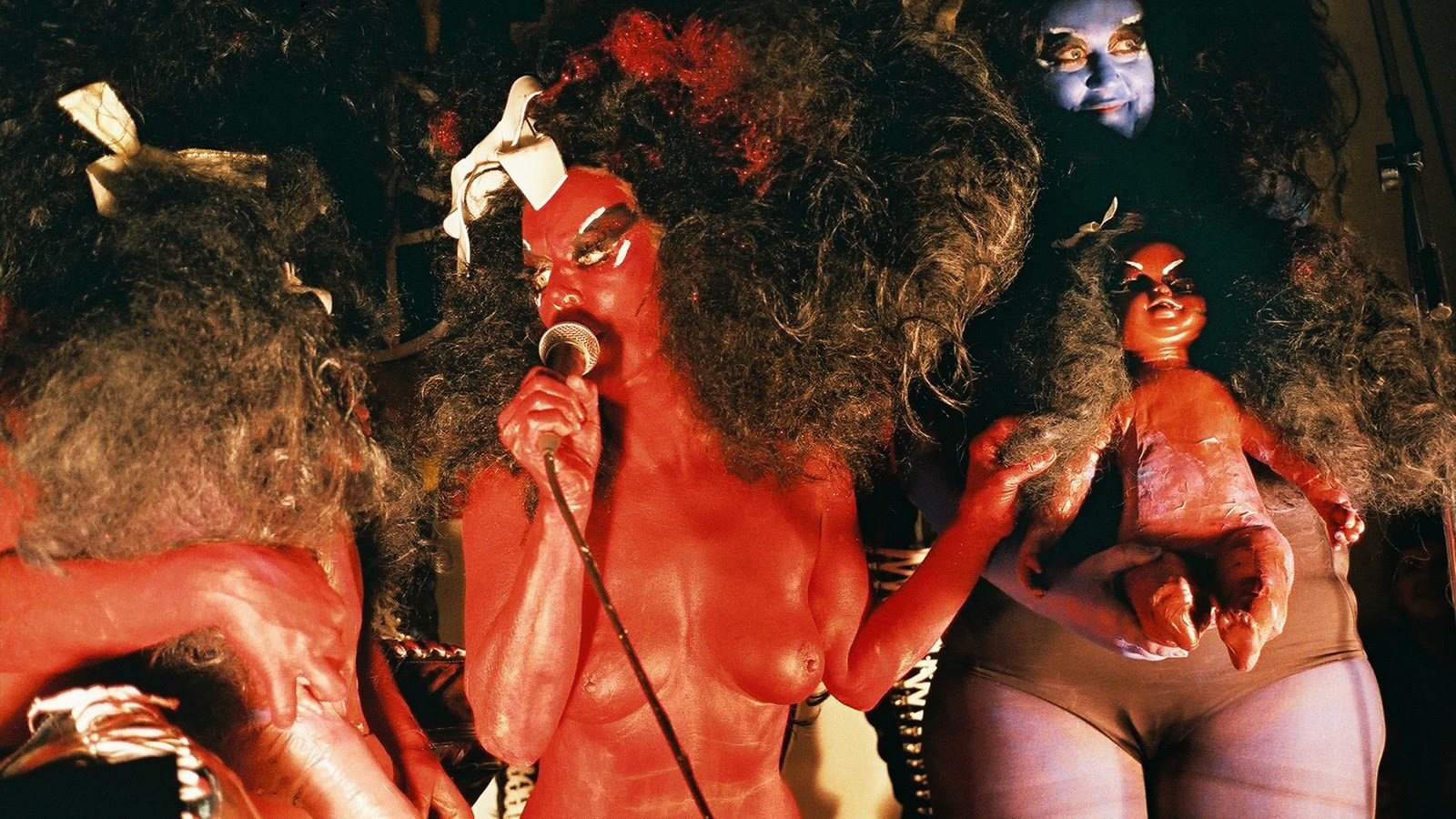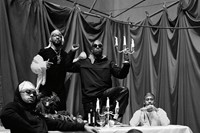We go deep with the art legend – who appears in the new Helmut Lang campaign – on sacrificing everything for her work, the Aids crisis and having her vagina sewn shut
A black bushy wig with a crooked bow. Thigh-high laced vinyl boots. A naked body covered in red paint, heavily glittered eyes, teeth blackened after an old Japanese tradition practiced by wives and geishas. The woman on stage looks like a mixture of B-movie hellcat and Femlin, a mischievous character ripped from the pages of Playboy. She’s horrendous, and at the same time horribly seductive.
She’s joined onstage by half a dozen lookalikes. These “coven-meets-vaudeville” ladies dance to old rock riffs, roar their verses, and never smile. Eventually, they spread their legs and lay on top of each other so they build a ‘wall of vagina’ – an emphatic, living, breathing monument.
This is a Voluptuous Horror of Karen Black show, the theatrical punk band headed by New York City art legend Kembra Pfahler.
Pfahler is a real ‘anti-diva’, with a long shock list. By the mid-90s, she had already founded TVHKB, made love to the rubber octopus in Nick Zedd’s movie War Is Menstrual Envy and had her vagina sewn shut for Richard Kern’s Sewing Circle. Over this period, she polished her instantly recognisable artistic language, and coined the philosophy of availabilism. Now her hardcore output is acknowledged by highbrow art institutions like MoMA and the Whitney Museum, and she’s modelled for Calvin Klein, Rick Owens, Rodarte and Marc Jacobs. For a person involved in butt print painting and running The Punk Ladies of Wrestling federation, her forays into fashion almost seem like a prank – and now she features in the rebirth of Helmut Lang.
“I was perceived as ugly my whole life, it’s only since I started being embraced by the modelling fashion world that my bone structure started signifying something more fuckable – less horrific,” says Pfahler. “My ugliness got transformed by way of homage and perception. It has helped, having couture as a weapon. I thank my fashion jobs for that – rather than getting beaten up or chased down the street, people ask what size sharpie-marker I use for my eyebrows.”
In 2014, together with artists Anohni, Johanna Constantine, CocoRosie’s Bianca and Sierra Casady, Pfahler launched Future Feminism – a 13-day performance festival in NYC looking at “13 Tenets of Future Feminism”, the group’s political and ethical thoughts on the solutions to global problems. This month, the artists bring the exhibition to Aarhus, Denmark. Engraved on pink onyx crystal, tenet #1 says: “The subjugation of women and Earth is one and the same”.
Kembra Pfahler’s work is not always easy to understand or digest, and she admits it. Perhaps the best way to get the message is to see her live performances, unabashedly ironic and pagan, yet conscious and meticulously controlled, mocking the generally accepted notions of female beauty, targeting the cultural exploitation of women’s bodies. “She takes it and spits it back out with venomous power and force,” says Kayla Guthrie, an NYC-based artist and a graduate from Pfahler’s own Performance Art 101 class. “It’s extreme but not abject,” continues Guthrie. “It brings up complex reactions of disgust, pain, fear, delight and enjoyment all at once. It draws on all these subconscious brews of power and sexuality in our minds, bodies and emotions, and rolls them into a blasphemous image that is incredibly pure and focused, both very angry and very joyful.”
To discuss Pfahler’s eccentric life and career, and why being an artist still matters, we sat down in her East Village apartment. The famous place is fully painted in red – just like her body during the shows – and in the living room there are giant performance props of dicks and inverted crosses. A sure sign that Kembra’s work is what she truly is – if anyone ever doubted it.
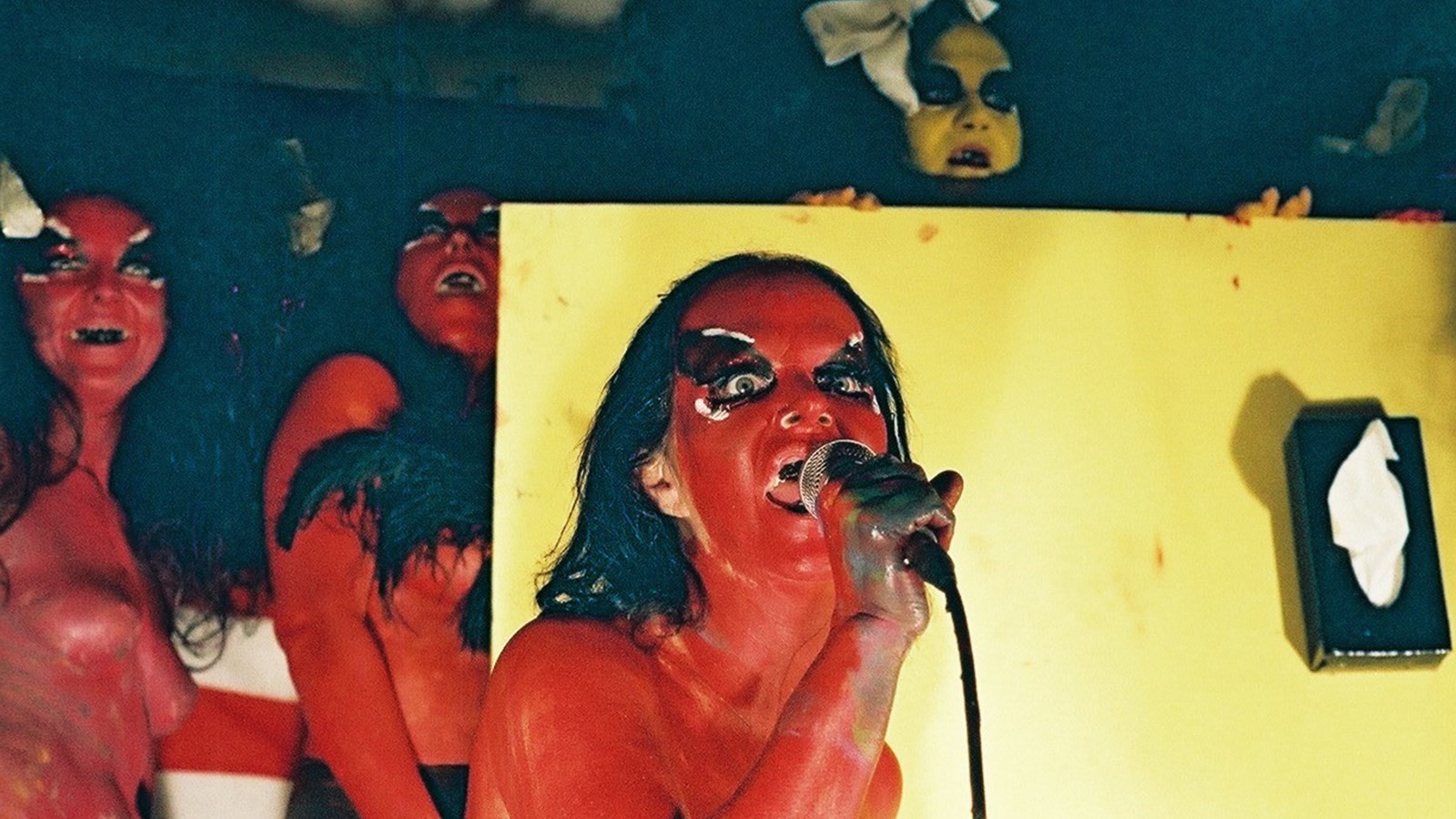
Kembra Pfahler: Hope you’re not allergic to cats. Say hi to this beauty, her name is Nina. She’s very affectionate, because she has only three legs.
Hi Nina. What happened to her?
Kembra Pfahler: She was just born like that. I’m not an obsessed cat person, but this one was abandoned on Avenue D so I took her. But she’s so cute, right? She likes you!
I’m not surprised you’re that charitable. From the students of your Performance Art 101 class, I’ve heard you are very giving – as a mentor, an artist and a person.
Kembra Pfahler: I’m really giving in my art. I can give it, say, my own health. It took me months to recover from previous Future Feminism shows as it caused problems with my back. I went really in-depth for Future Feminism so it depleted me, in a lot of aspects. It took a year to pay back money for all the tech people. It really tired me out.
Do you feel like it was worth it?
Kembra Pfahler: Absolutely. One hundred per cent.
Lots of artists tend to be quite careless about their health, are you like that?
Kembra Pfahler: I’m 55 years old now. I can’t complain about too many health things and I don’t follow a strict food programme. I ate for years like I was on tour with the band. A donut, a bagel, some greens. But I was never fanatical about health or food because largely my body luckily did what I wanted it to do. It followed my commands. I trained as a gymnast for years when I was young and was planning on going to the Olympics before I broke my elbow, and the course of my life shifted. The first person I loved more than any friend, Gordon Kurtti, died of Aids in the 80s and seeing the horror he and others endured always eclipsed my own health issues. I can’t stand going to the doctors, really. Although I don’t respond to holistic treatments. I need anti-natural cures and am a believer in antibiotics. Especially after being on the road for so long, I could never really afford to be sick and to lose dates. I hope this wellness continues. I don’t take it for granted.
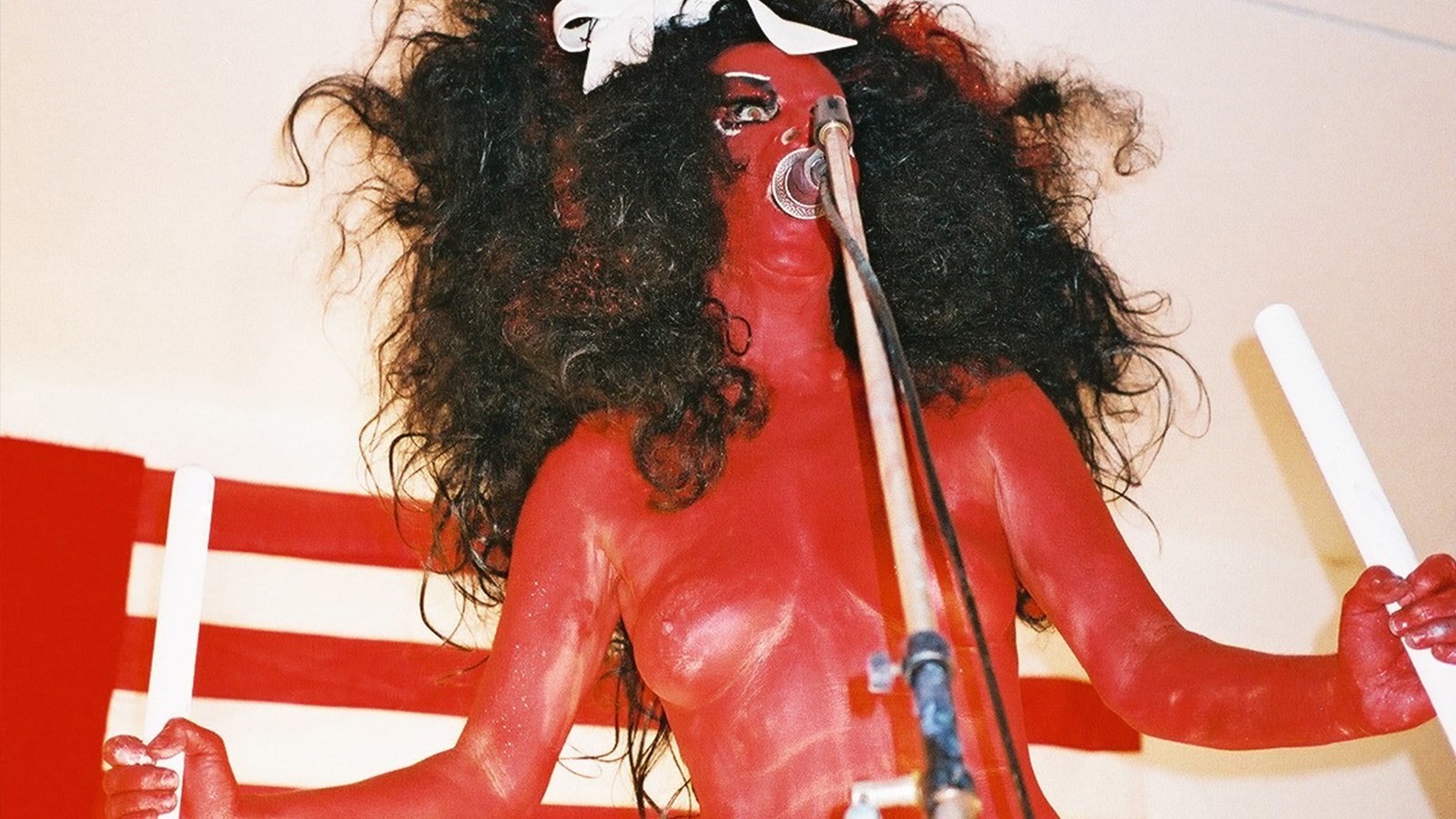
You speak openly about the things most people are secretive about. I saw the video where you’re gradually taking off your clothes and revealing everything about your problems with health, food, drug addictions and getting older.
Kembra Pfahler: Getting older is awesome. Especially being a woman – people start to take you more seriously. They shouldn’t, but they do. If you’re doing something for 20 years, people start to take you more seriously. They don’t question your integrity that much. And I’ve been doing my artwork for almost four decades, without ever stopping.
Have you ever questioned why it was always important for you to keep going?
Kembra Pfahler: Because in our country, the United States of America, we don’t have any mythological and cultural history. We never had any ritual or cultural celebration aside from surfing in California. I don’t know where my grandparents came from, I don’t know what my background is. I don’t really know the language of my people generations away. You know what I mean? I’m coming from Los Angeles and my blood is a mixture of many. I guess I’m European, I don’t know. But I know I am a surfer. My parents are surfers. The atmosphere around us was just one thing: surfing. Growing up with my hippie parents gave me an opportunity to invent my own cultural identity, my own mythology. I had an opportunity to create myself any way that I wanted to and I was encouraged to do so by my parents. I think I was born with a very heavy heart. I always escaped through imagination and always had desire to make things more beautiful. I felt it was frightening and ugly out there.
Why do you think such things as art and being artistic still matter in such politically anxious times?
Kembra Pfahler: My definition of art is creating moments of surprising beauty, and happiness. I don’t find that anywhere else. When art is pointing out the direction towards the truth, when art is good and strong, it tells us about what our future is going to be. It creates a prophecy, in a way. Artists are supposed to be visionaries of the culture, to see things differently and share those stories with the community. So art matters as long as human beings all matter. I think it’s one of the only things that human beings do that’s of any value. Everything else seems to be driven towards destruction. Human beings are crazy about killing things. I mean, we’ve done enough damage to destroy the planet Earth in only 200 years. Comparatively, it took billions of years to make the planet. So I think art matters because art is not destruction, it’s not war. It’s one of the nicest things that human beings can contribute. It’s also just pleasurable to make art, right? And to share it.
“I think (art) is one of the only things that human beings do that’s of any value. Everything else seems to be driven towards destruction. Human beings are crazy about killing things” – Kembra Pfalher
Tell me more about your Performance Art 101 classes. What’s the main thing you’re trying to teach your students?
Kembra Pfahler: I don’t feel like I’m a teacher, more of just an art facilitator and friend. What I’m teaching and what I’m doing with the people in my class is not my own work. On the first day, I tell everyone, ‘Today you’ve graduated and I give everyone an A+. Take away all of your feelings of stress around finishing this class. You’ve done perfectly well and you have the courage for showing up.’ So we graduate on the first day. We do everything the opposite way to how they do in a regular school. We’re irregular, contrarian. I tell everyone, ‘We’re here to make your work better and to learn about your vocabulary of images.’ I show them how to set the temperature for getting better with their work. Being an artist, you have to create an atmosphere from which your best work comes out. If you’re writing – it’s how to do your best writing. Maybe you also have to have your studio set up in a proper way. So that’s what we do at Performance Art 101. It’s called 101 because it’s really the basics of how to set up your studio, your work day. How every day we wake up and do writing projects, drawing projects, so it’s very busy.
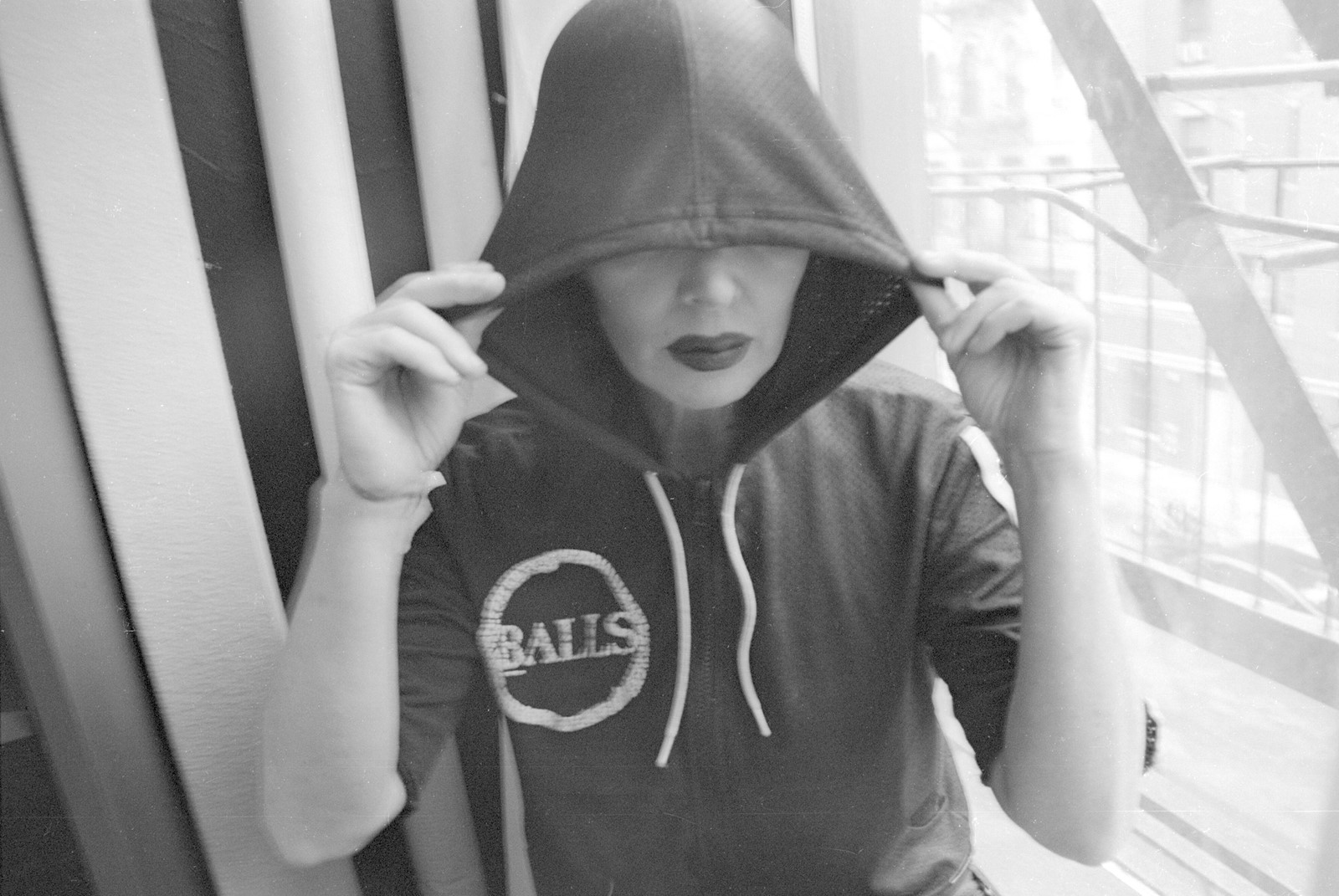
Are you into that black-and-white vision that some people are real artists and others aren’t? To your mind, can everyone be an artist or no?
Kembra Pfahler: They totally can. But if they want to spend all day and all night being an artist, that’s another thing. I think it’s more like discipline. Do you want to work 24 hours a day on your art? Do you want to sacrifice? For many people, it’s also important to have a life. I never had a life except for art life. My art always came between me and my personal relationships. I was married once for 18 years successfully so I had some good relationships, but my art always caused a bit of tension.
Samoa Moriki, your ex-husband and co-founder of the Voluptuous Horror of Karen Black, is an artist too. You’ll even be curating his upcoming painting show at the Howl gallery in NYC. So his art wasn’t such a big thing in your relationships as yours?
Kembra Pfahler: His art was important too. When we were young, what I did was upsetting to him, I think. My art was a little aggressive at that time and I think it was difficult. I was in Penthouse with my vagina sewn shut, you know. So we had to take a break for a little while, and we did it in 2000 and we stopped doing The Voluptuous Horror of Karen Black too. Samoa has been the most important artistic relationship to me. He’s my ex-husband now but he’s an important friend.
“I was in Penthouse with my vagina sewn shut, you know. So we had to take a break for a little while” – Kembra Pfahler
So even artists can’t handle such things sometimes.
Kembra Pfahler: For the most part, they definitely can’t handle that.
What would you advise female artists in their relationships with men?
Kembra Pfahler: Just talk about things. And have clarity in what you’re doing. If you’re doing something that involves nudity and your body, don’t act impiously. Just think, will you love that work in ten years? Why are you doing it? Is it a destructive impulse or is it an impulse you’re ready to live with forever? Do you think it’s beautiful? Can you show this to your parents? Can you talk about this during Christmas at the table?
Through the description of your parents it seems like they should have understood.
Kembra Pfahler: I had no desire to be secretive about my work so I would be talking about my sewn vagina at the Thanksgiving table. They understood because they tried to understand. And I know that it was difficult for my parents. But with my artwork, I was out of the closet for my whole life. An extra suggestion to young female artists is, don’t be secretive. Because they will always find out. You can’t be secretive about your identity. Unless you’re in the situation where you’ll be thrown in jail and will never be able to come out, there’s no reason to be secretive. In America, we have these kind of freedoms, so I didn’t want to create a fictitious character and not let my parents see my work. I wanted to be very open about it and I am glad I was.
So you don’t regret any of the things in art you’ve done.
Kembra Pfahler: None of them. But some of the people that worked with me did. They had revisionism when they wanted to change their mind about their participation, to take their name and image out of Karen Black or any of my work because they got into relationships where their boyfriends didn’t like me. In some cases their men were even jealous of the band and my visibility. So stupid. Now I’m very careful to choose people that I work with. I will only work with people with whom we’ve talked about everything we’re going to do. I ask them the same thing I told you: ‘Can you handle this ten years from now?’ I would not regret anything, but when some of my collaborators did, it was very painful. I’ve learned it the hard way.

Those women who left you, how did they end up?
Kembra Pfahler: One of them died. The other one is sitting at home with children.
Have you ever wanted to have a family life too?
Kembra Pfahler: Yes, I wanted to have family. I don’t have biological children but I have young kids in the band whom I can help, for whom I can be a mother too. I was trying to have a child with Colin de Land, he had a gallery called American Fine Arts. But he died of cancer. Life and death walk closely… I know this pretty well since I’m from the country where there is an ongoing war crisis. There is a war here in America too – Aids, cancer, poverty, political tensions to some point. I feel like the amount of tragedy is practically the same everywhere. My experience with Aids and death is not unusual. In the 80s, half of New York City had just died out. It was like a plague. So terrifying.
I can imagine how terrifying it was, since nobody knew the disease well.
Kembra Pfahler: Yes, nobody even knew what Aids was. I remember I wasn’t allowed to go and visit my friends in the hospital room, because the hospital was too afraid to have visitors. Everybody wore those biohazard protection suits. I feel like I have a trauma from that time similar to the one people have after the hell of war. I’m a veteran.
“The hospital was too afraid to have visitors. Everybody wore those biohazard protection suits. I feel like I have a trauma from that time similar to the one people have after the hell of war. I’m a veteran” – Kembra Pfahler
If there’s hell, is there heaven? Did this lead you to some more religious outlook on life?
Kembra Pfahler: Well, no. I think there’s an energy in the afterlife, and when everything shatters, you leave some energy and it travels here or there. Me, personally, I think I’ll just leave. And I hope to leave something behind. I’m not worried. Oh my God, I’ve looked in the mirror now and I see I haven’t brushed my hair in 20 years... So, yes, to tell you the truth, I can’t express my feelings towards heaven and hell in words. If I begin talking about it, it would just sound ridiculous. I feel that it’s something I have to keep close to my heart and usually if I meet people in person, they can identify my belief system by just being around me. And I definitely have this belief system.
How can one use the ideas in availabilism in everyday life?
Kembra Pfahler: Make the best use of what’s available. Use what is available around you. You don’t have to suffer with your work. If you’re a filmmaker, you don’t need to raise ten million dollars to make a film. You should not be a prisoner of your medium, it can really waste your time. There is a lot of material available.
Yeah, everybody has this photographer friend who thinks he would take better pictures…
Kembra Pfahler: ...if his camera is better. Bullshit! I believe good artwork consists of nice ideas and content, not of technique really. Some people would not agree with this attitude, I know.
And a lot of us also know a person who’s very talented but always has doubts that really stop him from going. For example, I have a friend who could be better than Ron Athey some day but often he destroys everything he’s done as he detests exposing his work. Not that art has to be a career necessarily, of course.
Kembra Pfahler: It’s kind of nihilism on his part, yes? Well, right, art really has nothing to do with career. Art is art. So all the outsides shouldn’t matter, you know. A real artist, he just works. That’s it. He just has to work, there’s no question about it. He’ll have good days and bad days. Good months and bad months. But it doesn’t serve him personally to be hopeless. The only person who gets hurt if he doesn’t work is himself. The world doesn’t care. But his soul will care. It’s not good for an artist to not work. An artist has to work. I have never felt like this in my whole life so I don’t really understand that kind of attitude. I never had doubts. Isn’t that weird?
Good for you, so many people have them.
Kembra Pfahler: Doubt is the greatest enemy of an artist. The only thing you need to be an artist is courage and audacity. You don’t even need talent. Let’s check ‘audacity’ in the dictionary. It means shamelessness, boldness or daring, especially with confidence and arrogance. So any artists who have doubts just hurt themselves. And it’s not fun to hurt yourself. It’s kind of boring. And sometimes, a disregard for your own safety says ‘I want to remain safe’, actually. Male artists are lucky they have women. A lot of times women are the ones that have to be cheerleaders, getting that energy and confidence out of him. Because we are so strong and we can help you, and you, and 20 other people too and still be OK.
